What We’re Reading: June 29th
Auxin methylation is required for differential growth in Arabidopsis
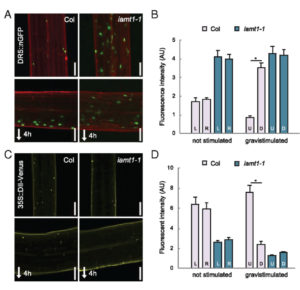 Plants need to navigate and adjust their growth according to the environmental clues, such as light or gravity. Asymmetric distribution of auxin is necessary for organ bending. Abbas and colleagues show that conversion of indole-3-acetic acid (IAA) into methyl-IAA (Me-IAA) is important for asymmetric auxin distribution. Mutation of IAA carboxyl methyltransferase 1 (IAMT1) resulted in decreased in Me-IAA and impaired response to gravity stimulation. The iamt1 mutants exhibited higher auxin transport and their gravity response could be rescued by using low concentrations of auxin-transport inhibitor (NPA). Higher expression of auxin transporters (PIN) and reduced re-localization in response to gravity stimulus explains the reduced gravity response of the iamt1 mutants. The rescue of auxin methylation specifically in the endodermis rescued the agravitropic phenotype of iamt1 mutants. (Summary by Magdalena Julkowska) PNAS Proc. Natl. Acad. Sci. USA 10.1073/pnas.1806565115
Plants need to navigate and adjust their growth according to the environmental clues, such as light or gravity. Asymmetric distribution of auxin is necessary for organ bending. Abbas and colleagues show that conversion of indole-3-acetic acid (IAA) into methyl-IAA (Me-IAA) is important for asymmetric auxin distribution. Mutation of IAA carboxyl methyltransferase 1 (IAMT1) resulted in decreased in Me-IAA and impaired response to gravity stimulation. The iamt1 mutants exhibited higher auxin transport and their gravity response could be rescued by using low concentrations of auxin-transport inhibitor (NPA). Higher expression of auxin transporters (PIN) and reduced re-localization in response to gravity stimulus explains the reduced gravity response of the iamt1 mutants. The rescue of auxin methylation specifically in the endodermis rescued the agravitropic phenotype of iamt1 mutants. (Summary by Magdalena Julkowska) PNAS Proc. Natl. Acad. Sci. USA 10.1073/pnas.1806565115
Arabidopsis duodecuple mutant of PYL ABA receptors reveals PYL repression of ABA-independent SnRK2 activity
 Abscisic acid (ABA) is a plant hormone involved in many plant processes – from seed maturation to drought responses. ABA is perceived by intracellular pyrabactin resistance and PYR-like family (PYR/PYL) receptors, counting 14 genes in Arabidopsis, representing the largest family of plant receptors. Although individual PYLs differ in their expression patterns, it is hard to dissect ABA-dependent processes due to some degree of redundancy. Zhao and colleagues generated a duodecuple mutant, knocking out 12 out of 14 PYL genes using a combination of T-DNA insertion lines and CRISPR/Cas9 gene silencing. The 12-fold mutant was resistant to ABA-induced inhibition of germination, growth and closing of the stomata. Mutation of twelve ABA receptors reduced the transcriptional responses to ABA by 93%. Interestingly, only 54% of transcriptional responses to osmotic treatment were impaired in the twelve-fold mutant, suggesting that roughly half of the plant osmotic responses is regulated independently of ABA. (Summary by Magdalena Julkowska) Cell Reports 10.1016/j.celrep.2018.05.044
Abscisic acid (ABA) is a plant hormone involved in many plant processes – from seed maturation to drought responses. ABA is perceived by intracellular pyrabactin resistance and PYR-like family (PYR/PYL) receptors, counting 14 genes in Arabidopsis, representing the largest family of plant receptors. Although individual PYLs differ in their expression patterns, it is hard to dissect ABA-dependent processes due to some degree of redundancy. Zhao and colleagues generated a duodecuple mutant, knocking out 12 out of 14 PYL genes using a combination of T-DNA insertion lines and CRISPR/Cas9 gene silencing. The 12-fold mutant was resistant to ABA-induced inhibition of germination, growth and closing of the stomata. Mutation of twelve ABA receptors reduced the transcriptional responses to ABA by 93%. Interestingly, only 54% of transcriptional responses to osmotic treatment were impaired in the twelve-fold mutant, suggesting that roughly half of the plant osmotic responses is regulated independently of ABA. (Summary by Magdalena Julkowska) Cell Reports 10.1016/j.celrep.2018.05.044
Diacylglycerol acyltransferase 1 contributes to freezing tolerance
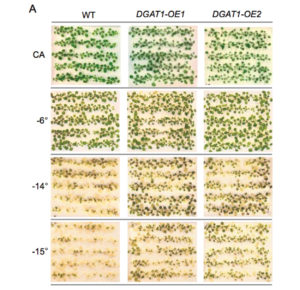 Low temperature is one of the environmental factors limiting the plant distribution. Yet there are some plants that can survive freezing temperatures, such as Boechera stricta, native to the Rocky Mountains, spread across a broad range of elevations. Arisz and colleagues observed that freezing tolerance was higher in the LTM ecotype (found in the northern high range) than in the SAD12 ecotype (native to southern slopes.) The QTL analysis of the bi-parental population identified a locus containing CoA:diacylglycerol O-acyltransferase 1 (DGAT1). The expression of BsDGAT1 was observed to be higher in the LTM ecotype and corresponded with higher levels of triacylglycerol. Overexpression of Arabidopsis DGAT1 resulted in increased freezing tolerance. The authors speculate that DGAT1 might be specifically important for protecting the membrane fluidity of the chloroplasts in freezing temperatures. (Summary by Magdalena Julkowska) Plant Physiol. 10.1104/pp.18.00503
Low temperature is one of the environmental factors limiting the plant distribution. Yet there are some plants that can survive freezing temperatures, such as Boechera stricta, native to the Rocky Mountains, spread across a broad range of elevations. Arisz and colleagues observed that freezing tolerance was higher in the LTM ecotype (found in the northern high range) than in the SAD12 ecotype (native to southern slopes.) The QTL analysis of the bi-parental population identified a locus containing CoA:diacylglycerol O-acyltransferase 1 (DGAT1). The expression of BsDGAT1 was observed to be higher in the LTM ecotype and corresponded with higher levels of triacylglycerol. Overexpression of Arabidopsis DGAT1 resulted in increased freezing tolerance. The authors speculate that DGAT1 might be specifically important for protecting the membrane fluidity of the chloroplasts in freezing temperatures. (Summary by Magdalena Julkowska) Plant Physiol. 10.1104/pp.18.00503
Biogenesis of thylakoid assembly in 3D
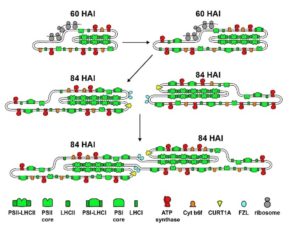 During seedling greening, chloroplasts are formed from proplastids. Liang and Zhu et al. used a combination of 3D electron tomography of cryo-fixed Arabidopsis cotyledons at various times after illumination to track their development. The fine structure images, accompanied by transcriptomic analysis and immunogold labelling studies, provide a detailed picture of the developmental changes that occur during plastid biogenesis, particularly the formation of the thylakoid structures. Additionally, the authors analyze mutants deficient in chloroplast ribosome production and a dynamin-like protein involved in thylakoid membrane fusion. (Summary by Mary Williams) Plant Cell 10.1105/tpc.17.00972
During seedling greening, chloroplasts are formed from proplastids. Liang and Zhu et al. used a combination of 3D electron tomography of cryo-fixed Arabidopsis cotyledons at various times after illumination to track their development. The fine structure images, accompanied by transcriptomic analysis and immunogold labelling studies, provide a detailed picture of the developmental changes that occur during plastid biogenesis, particularly the formation of the thylakoid structures. Additionally, the authors analyze mutants deficient in chloroplast ribosome production and a dynamin-like protein involved in thylakoid membrane fusion. (Summary by Mary Williams) Plant Cell 10.1105/tpc.17.00972
Synthesis and assembly of the PSII core subunits
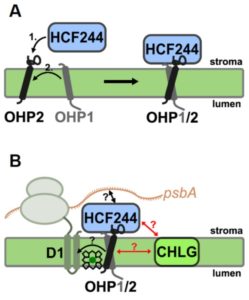 Plants have many proteins found in the light-harvesting complex, whereas cyanobacteria have only the high-light-inducible proteins (Hlips). One-helix proteins (OHPs) are the plant homologs of Hlips, but their precise functions have been unclear. Hey and Grimm used genetic and biochemical approaches to explore OHP function in Arabidopsis. The two Arabidopsis OHPs, OHP1 and OHP2, heterodimerize and also interact with the PSII assembly factor HIGH CHLOROPHYLL FLUORESCENCE 244 (HCF244). Interestingly, the stability of the three proteins is dependent on them accumulating concurrently. In VIGS-OHP2 plants (virally silenced OHP2), levels of core PSII subunits including D1 were also diminished, indicating that OHPs have similar functions to cyanobacterial Hlips. (Summary by Mary Williams) Plant Physiol. 10.1104/pp.18.00540
Plants have many proteins found in the light-harvesting complex, whereas cyanobacteria have only the high-light-inducible proteins (Hlips). One-helix proteins (OHPs) are the plant homologs of Hlips, but their precise functions have been unclear. Hey and Grimm used genetic and biochemical approaches to explore OHP function in Arabidopsis. The two Arabidopsis OHPs, OHP1 and OHP2, heterodimerize and also interact with the PSII assembly factor HIGH CHLOROPHYLL FLUORESCENCE 244 (HCF244). Interestingly, the stability of the three proteins is dependent on them accumulating concurrently. In VIGS-OHP2 plants (virally silenced OHP2), levels of core PSII subunits including D1 were also diminished, indicating that OHPs have similar functions to cyanobacterial Hlips. (Summary by Mary Williams) Plant Physiol. 10.1104/pp.18.00540
Rice tiller angle mediated by the LAZY1-dependent asymmetric distribution of auxin
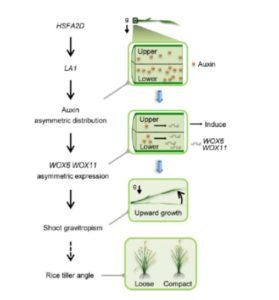 The angle at which leaves extend are held in a rice plant (tiller angle) affects the plant’s ability to intercept light and therefore potential yield. Genetic studies have identified a few genes involved in tiller angle, including the LAZY1 gene that encodes a protein involved in auxin transport. To identify other genes involved in this process, Zhang, Yu and Yu et al. looked at gene expression as rice seedlings responded to gravistimulation after being rotated 90°. The authors identified a HSFA2D, an upstream-acting transcription factor which when knocked out led to increased tiller angles, and two transcription factors (WOX6 and WOX11) that act redundantly downstream of auxin. As the authors summarize, “Collectively these approaches will identify genes to improve grain yields by facilitating the optimization of plant architecture”. (Summary by Mary Williams) Plant Cell10.1105/tpc.18.00063
The angle at which leaves extend are held in a rice plant (tiller angle) affects the plant’s ability to intercept light and therefore potential yield. Genetic studies have identified a few genes involved in tiller angle, including the LAZY1 gene that encodes a protein involved in auxin transport. To identify other genes involved in this process, Zhang, Yu and Yu et al. looked at gene expression as rice seedlings responded to gravistimulation after being rotated 90°. The authors identified a HSFA2D, an upstream-acting transcription factor which when knocked out led to increased tiller angles, and two transcription factors (WOX6 and WOX11) that act redundantly downstream of auxin. As the authors summarize, “Collectively these approaches will identify genes to improve grain yields by facilitating the optimization of plant architecture”. (Summary by Mary Williams) Plant Cell10.1105/tpc.18.00063
Network modelling unravels mechanisms of crosstalk between ethylene and salicylate signalling in potato
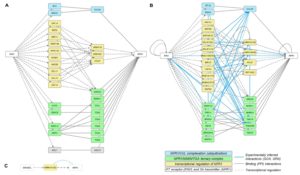 Potato is susceptible to many pathogens. To facilitate breeding programs, Ramšak et al. combined transcriptomic data from potato/virus interactions with a defense network model developed mainly from Arabidopsis. Their model revealed a previously undescribed interaction between ethylene and salicylate signalling, involving the direct transcriptional regulation of NPR1 by EIN3, indicating that transcriptional as well as post-transcriptional regulation of NPR1 contributes to immune signalling. This interaction was functionally validated in potato as well as Arabidopsis. (Summary by Mary Williams) Plant Physiol.10.1104/pp.18.00450
Potato is susceptible to many pathogens. To facilitate breeding programs, Ramšak et al. combined transcriptomic data from potato/virus interactions with a defense network model developed mainly from Arabidopsis. Their model revealed a previously undescribed interaction between ethylene and salicylate signalling, involving the direct transcriptional regulation of NPR1 by EIN3, indicating that transcriptional as well as post-transcriptional regulation of NPR1 contributes to immune signalling. This interaction was functionally validated in potato as well as Arabidopsis. (Summary by Mary Williams) Plant Physiol.10.1104/pp.18.00450



